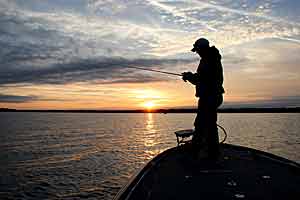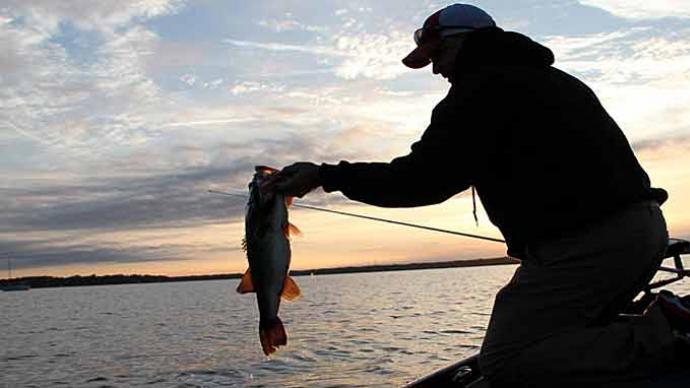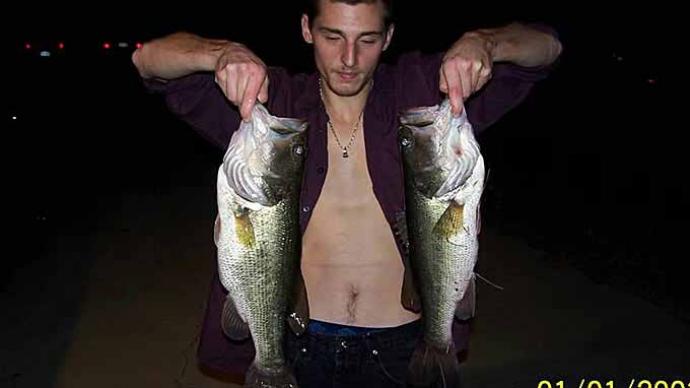
The time is 1:45 a.m. Very few vehicles can be heard passing over the bridges of Lake Fork. Most people are asleep. They are dreaming, perhaps of tomorrow or fishing trips to come. But for some this is prime lunker time.
Night fishing is an acquired taste. If you fish in the south where hot, summer temperatures can soar during the day, you may want to become acquainted with the art of fishing in the dark.
Some people view night fishing as spooky, exasperating, and even dangerous, but with proper care and common sense it can also be extremely enjoyable. This is not to mention how very productive it can be.
The possibility of catching the bass of a lifetime on a warm, summer night is very real. Big bass will often move better at night than during the daylight hours. When they are moving, the chance of you catching them increases.
My night fishing season starts when the surface temperature of the water slides into the lower 80's. This is usually mid-June on Lake Fork, where I guide. During the day fish can still be caught, but the hot Texas sun can exact a toll. For me, night time is the right time.
Largemouth bass have excellent night vision. The fish's eyes have much denser sets of light-gathering rods than do human eyes. It would seem that nature has equipped bass properly to feed at night as well as during the day.
Do not think that because you can't see at night that the bass can't either. Their low-light vision is far superior to ours, plus they use other sensory organs such as their lateral line to locate and consume prey.
For bass, water acts as a superb conductor of sound. Water is much denser than air, so sound travels farther and faster in water. At a distance, bass use their inner ears to hone in on prey. Up close, the lateral line tells them what's potentially edible and moving their way.
For night fishing I keep my tackle selection simple. A jig and plastic trailer, ½-ounce black spinnerbait, and a 10-inch worm rigged Texas style will be about all I'll carry. Black is probably the best color choice. This is because in low light, the rods in a fish's eye move to the front of the retina while the color receptors recede. This enhances the fish's light gathering capabilities while color sensing diminishes. Since black is the densest color, it shows up well, thus providing the best visual target against the light surface and night sky.
For night fishing I primarily fish shallow water. I concentrate on water 12 feet deep or less. Weed lines and structure breaks in areas close to the main lake or on main-lake points will offer you the best opportunities for catching night cruising bass.
Of course anglers who do not like fishing weeds during the day cannot be expected to like fishing them at night. That is, until they feel that thud, tap, or bone jarring strike from an oversized girl heading for deep water. I have seen many opinions changed and lots of line broken after a night of pitching jigs into deep grass banks.
Due to the fact that I fish a lot of heavy cover, stout equipment is a must. A heavy action rod, good quality baitcasting reel, and heavy line is definitely in order for this type of fishing. My personal preference is Power Pro Braid. Fish just don't seem to be able to break it.
As summer progresses, many anglers report having trouble catching fish. I think this is because they fish too fast. You can't be in a hurry to get to the next hot spot and fish the area you are in properly. Very few bass are caught by running across the lake.
Big bass choose their sanctuary areas for security and food sources. They move from one location to another with security in mind. If you hook a big fish it will immediately try to wrap the line around anything convenient like a tree limb, clump of weeds, or a boat prop. Large bass are like whitetail deer. They acquire survival instincts with age. This is why a slow presentation and covering water thoroughly is so important.
I'd like to stress two points in closing. First, while fishing at night be very careful and cautious. Know the water you're on and slow down on the throttle. If possible, always take someone with you and make sure someone at home knows when you're supposed to get there. Then when you do catch that big fish, please don't kill her. It took her anywhere from six to 10 years to get that big. She survived in spite of some pretty harsh odds to reach a size that you want to have your picture taken with her. So do that. And be sure to get some measurements for a replica, the release her to make memories for another angler.
Who knows, it might even be you again.




